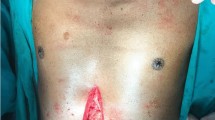Abstract
Introduction
Colonic bypass for corrosive-induced esophageal stricture is traditionally performed using an open approach. The laparoscopic mid-colon retrosternal esophageal bypass has not been previously reported. The present study is aimed to report the feasibility of laparoscopic mid-colon esophagocoloplasty and to compare the short- and medium-term outcomes with the open approach.
Materials and methods
Patients who underwent surgery for corrosive esophageal stricture between August 2016 and August 2019 were retrospectively analyzed. Laparoscopic procedure was preferred in patients with stricture starting at or below the level of cricopharynx and without prior laparotomy. The perioperative and medium-term outcomes of patients who underwent open and laparoscopic mid-colon bypass were compared.
Results
Of the 15 patients, seven patients underwent laparoscopic mid-colon bypass, and eight patients underwent the open procedure. The duration of surgery was less in the laparoscopic group, but the difference was not significant (440 vs. 510 min, P = 0.93). Intraoperative blood loss (median) and postoperative analgesic requirement (median days) were significantly lower in laparoscopic group (200 mL vs. 350 mL, P = 0.03 & 3 vs. 5, P = 0.02). There was no significant difference in the postoperative complications, ICU and hospital stay between the two groups. At a median (range) follow-up of 14 (7–42) months, all patients in the minimally invasive colon bypass group were euphagic to regular Indian diet. Two patients in the open group developed anastomotic stricture requiring endoscopic dilatation.
Conclusion
Minimally invasive mid-colon esophageal bypass is a feasible procedure for selected patients with corrosive esophageal stricture with favorable short-term and comparable medium-term outcomes.




Similar content being viewed by others
References
Kalayarasan R, Ananthakrishnan N, Kate V (2019) Corrosive ingestion. Indian J Crit Care Med 23:S282–S286
Ananthakrishnan N, Kalayarasan R, Kate V (2016) Corrosive injury of esophagus and stomach. In: Mishra PK (ed) Textbook of surgical gastroenterology, 1st edn. Jaypee, New Delhi, pp 194–206
Javed A, Pal S, Dash NR, Sahni P et al (2011) Outcome following surgical management of corrosive strictures of the esophagus. Ann Surg 254:62–66
Zeng WH, Jiang WL, Kang GJ et al (2019) Colon interposition for corrosive esophageal stricture: single institution experience with 119 cases. Curr Med Sci 39:415–418
DeMeester SR (2001) Colon interposition following esophagectomy. Dis Esophagus 14:169–172
Kochhar R, Sethy PK, Kochhar S, Nagi B et al (2006) Corrosive induced carcinoma of esophagus: report of three patients and review of literature. J Gastroenterol Hepatol 21:777–780
Okonta KE, Tettey M, Abubakar U (2012) In patients with corrosive oesophageal stricture for surgery, is oesophagectomy rather than bypass necessary to reduce the risk of oesophageal malignancy? Interact Cardiovasc Thorac Surg 15:713–715
Ananthakrishnan N, Subbarao KS, Parthasarathy G et al (2014) Long term results of esophageal bypass for corrosive strictures without esophageal resection using a modified left colon esophagocoloplasty—a report of 105 consecutive patients from a single unit over 30 years. Hepatogastroenterology 61:1033–1041
Javed A, Agarwal AK (2013) Total laparoscopic esophageal bypass using a colonic conduit for corrosive-induced esophageal stricture. Surg Endosc 27:3726–3732
Banerjee JK, Bharathi RS (2017) Minimally invasive substernal colonic transposition for corrosive strictures of the upper aerodigestive tract. Dis Esophagus 30:1–11
Lin TS, Kuo SJ, Chou MC (2003) Hand-assisted laparoscopic colon mobilization for esophageal reconstruction. Surg Endosc 17:115–117
Esteves E, Sousa-Filho HB, Watanabe S et al (2010) Laparoscopically assisted esophagectomy and colon interposition for esophageal replacement in children: preliminary results of a novel technique. J Pediatr Surg 45:1053–1060
Ananthakrishnan N, Parthasarathy G, Kate V (2007) Use of spiral CT to demonstrate esophageal lumen in corrosive strictures. Indian J Gastroenterol 26:101
Ananthakrishnan N, Subba Rao KSVK, Radjendirin P (1993) Mid-colon esophagocoloplasty for corrosive esophageal strictures. Aust N Z J Surg 63:389–395
Ananthakrishnan N, Kate V, Parthasarathy G (2011) Therapeutic options for management of pharyngoesophageal corrosive strictures. J Gastrointest Surg 15:566–575
Nagaraj K, Kalayarasan R, Gnanasekaran S, et al (2018). Total laparoscopic Billroth-I gastrectomy for corrosive-induced antropyloric stricture. J Minim Access Surg Jun 27. [Epub ahead of print].
Bhati G, Kalayarasan R, Pottakkat B (2017) Laparoscopic feeding jejunostomy: a simple technique using Kehr’s T-tube. J Laparoendosc Adv Surg Tech Part B Videoscopy. https://doi.org/10.1089/vor.2016.0347
Chirica M, Brette MD, Faron M et al (2015) Upper digestive tract reconstruction for caustic injuries. Ann Surg 261:894–901
Gerzic ZB, Knezevic JB, Milicevic MN et al (1990) Esophagocoloplasty in the management of postcorrosive strictures of the esophagus. Ann Surg 211:329–336
Han Y, Cheng QS, Li XF et al (2004) Surgical management of esophageal strictures after caustic burns: a 30 years of experience. World J Gastroenterol 10:2846–2849
Author information
Authors and Affiliations
Corresponding author
Ethics declarations
Conflict of interest
The authors have declared no competing financial interests.
Additional information
Publisher's Note
Springer Nature remains neutral with regard to jurisdictional claims in published maps and institutional affiliations.
Electronic supplementary material
Below is the link to the electronic supplementary material.
Supplementary file 1 (WMV 125118 kb)
Rights and permissions
About this article
Cite this article
Gurram, R.P., Kalayarasan, R., Gnanasekaran, S. et al. Minimally Invasive Retrosternal Esophageal Bypass Using a Mid-Colon Esophagocoloplasty for Corrosive-Induced Esophageal Stricture. World J Surg 44, 4153–4160 (2020). https://doi.org/10.1007/s00268-020-05719-4
Accepted:
Published:
Issue Date:
DOI: https://doi.org/10.1007/s00268-020-05719-4




